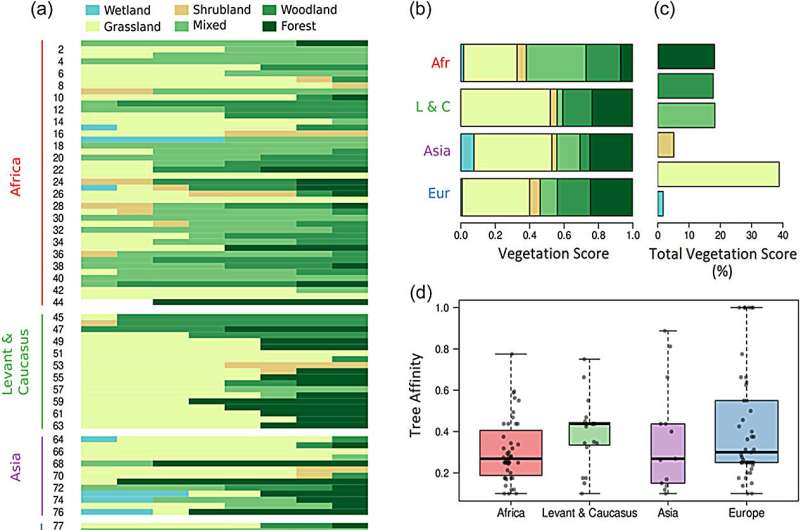This article has been reviewed according to Science X's editorial process and policies. Editors have highlighted the following attributes while ensuring the content's credibility:
fact-checked
trusted source
proofread
New research exposes humans' early ecological versatility

A recent study by University of Helsinki researchers sheds new light on the ecological adaptability of early humans at the time when they first expanded their range outside Africa, from 2 million to 1 million years ago.
The origins of the genus Homo have long been associated with savannah and grassland environments of Africa. Due to this association, it was thought that the first human dispersal into Eurasia followed grassy corridors leading from Africa to Asia and to Europe.
This link between humans and savannah–grasslands has been considered so strong that it delayed the appearance of early humans in Europe compared to Asia, as open grassy environments appeared in Europe later than in Asia. According to this view, early humans were ecologically clearly less versatile than our own species, Homo sapiens, as we have colonized almost all terrestrial environments on the planet.
"But that's clearly not the whole story" says the lead author Tegan Foister, a doctoral researcher in the Hominin Ecology group at the University of Helsinki. "Because we knew of some studies suggesting that early humans were living in environments other than savannah–grassland, we thought that it would be interesting to do a more systematic investigation on the environments humans are known to have occupied during this crucial time period."
The research, published in Evolutionary Anthropology: Issues, News, and Reviews, is a systematic review of 121 previously published reconstructions of early human habitats. It reveals that humans, when dispersing out of Africa for the first time, started to occupy a diverse set of environments from grasslands to forests.
"We have long associated early humans with savannah-like environments outside of the African continent. However, when the research published over the past two decades is considered together, it shows humans inhabiting diverse environments early in the evolution of the genus Homo. Already 1 million years ago humans in Europe were occupying fully forested environments," Foister states.
Although the analysis shows that grasslands and savannahs were important components of early human habitats, it places humans into a wide spectrum of environments, and in many cases environments with varied vegetation composition. This suggests that commonly held believes about early humans are not entirely correct: Humans did not have that strict requirements for their habitats and they seem to have been ecologically more versatile than previously assumed.
The study also indicated regional differences in human habitat characteristics. The grasslands and savannahs show the highest prevalence among African habitats, whereas forested habitats were more prominent in Eurasia making the range of different habitats wider in Eurasia. This suggests a possibility that the first human range expansion into Eurasia was accompanied and potentially even enabled by the expansion of human ecological niche.
The research is part of a project that investigates the evolution of the human niche over the past 2 million years. Although the present study focuses on the early humans, its findings are important also to the understanding of the origins of uniquely wide niche of our own species Homo sapiens.
Co-author Miikka Tallavaara, leader of the project and the Hominin Ecology group, says, "The ability of Homo sapiens to occupy most of the terrestrial ecosystems has enabled our ecological dominance and triggered the current biodiversity crisis. Our finding that human species in the Early Pleistocene were also able to thrive in multiple environment types provides an exciting target for future research into the evolutionary origins of the human plasticity and ecological success."
More information: Tegan I. F. Foister et al, Homo heterogenus: Variability in early Pleistocene Homo environments, Evolutionary Anthropology: Issues, News, and Reviews (2023). DOI: 10.1002/evan.22005
Provided by University of Helsinki




















